To measure sexual behavior we are usually required to ask people about sexual behavior. There is a great deal of research on casual sex that simply asks people some version of: “Have you had casual sex?” Contrary to popular belief, lies or social desirability bias probably don’t shift self-reports on items like this very much (see: Is Self Reported Sexual Partner Data Accurate? and Did a fake polygraph catch women lying about their sexual partner count?).
Additionally, people overestimate the prevalence of promiscuity in the general population due to what I call “promiscuity narratives,” or media exposure to stories about promiscuity and social media anecdotes. This is related to the availability heuristic or bias, the tendency to overestimate the likelihood of events that are more memorable or more salient. In essence, the more you are exposed to pornstars on podcasts and fast life history strategy TikTokers, the more you will believe that these are typical behaviors. However, they are nowhere near representative of the sex lives of average people. You are observing people drawn from the tail ends of the sociosexuality (and often narcissism) distribution.
That said, promiscuity may be still mismeasured (overestimated or underestimated) across the psychological literature. This isn’t due to people saying “I didn’t have casual sex” when they did, but due to variance introduced by the nature of the question. In short, people may not actually agree on what casual sex is. Beyond academic literature, this may also result in people speaking past one another when having discussions about promiscuity and casual sex.
I ran a poll on X/Twitter and asked:
Imagine that a woman goes on three dates with a man who she is interested in having a relationship with. They have sex on the third date. Is this casual sex?
This question was inspired by the “three date rule,” which the Internet says was popularized by Sex and the City, and which serves as a general guideline a lot of people seem to follow. I have seen female-centered discourse around the “three date rule” which says this is how long one should wait and male-centered discourse that says if a woman does not have sex after three dates she is uninterested. I am not a sex historian and I have no clue what the real origin of this is, but it does seem to be a rule that a lot of people have incorporated into their dating lives.
The question above also includes knowledge that the intent of dating and sex in the given case is a relationship. This was to exclude perceptions of a motivation or desire in the fictional scenario for sex without the intent of the relationship. You might think that is what defines casual sex — sex within the pursuit or intent of a relationship versus sex without the intent of a relationship — but it turns out that many people disagree. Below are male and female responses to this question. 43.6% men and 50% of women see the scenario above as casual sex while half do not:
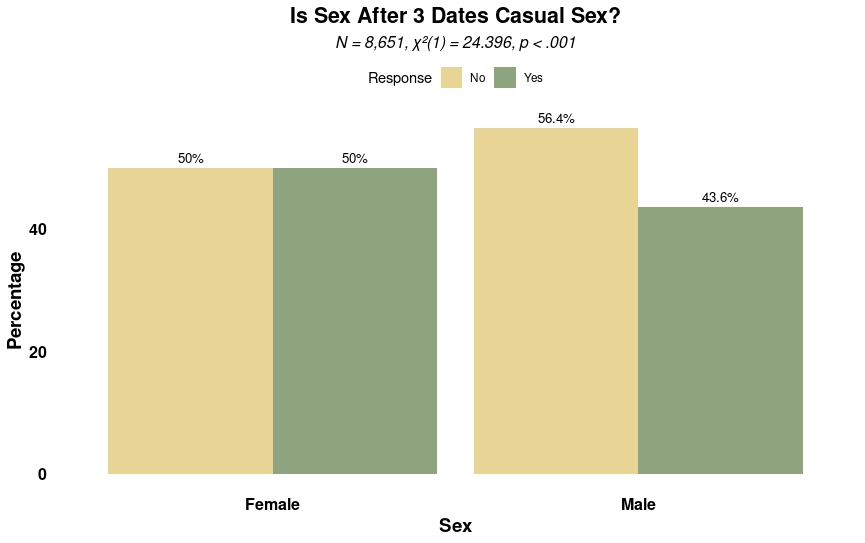
This result was surprising to me. I am in the “no” camp and was surprised at the size of the “yes” camp. Ultimately these are opinions and neither is demonstrably right or wrong. The important takeaway is that there is high disagreement both within men and women as to what constitutes “casual sex.”
A popular talking point within manosphere subcultures is that women will under-report “casual sex.” The results here are also contrary to this. Women were more likely to describe this as casual sex than men were (χ²(1) = 24.396, p < .001). Related to this is the claim that women will not count sex acts such as oral sex as sex, which also does not seem to be the case (see: Does Oral Sex Count As Having Sex?). Almost everyone counts their oral sex acts as sex if you simply ask “did you have sex.”
In an earlier poll I asked women: “Did you have casual sex within the past year?” 19.2% of women said that they did. We can compare this to the nationally representative General Social Survey (GSS) from 2022 (see: How Many Sexual Partners Did Men and Women Have in 2022?). For women within the age of my poll demographic (approximately 30 years old), only 10% reported having sex that was not within a “committed relationship.”
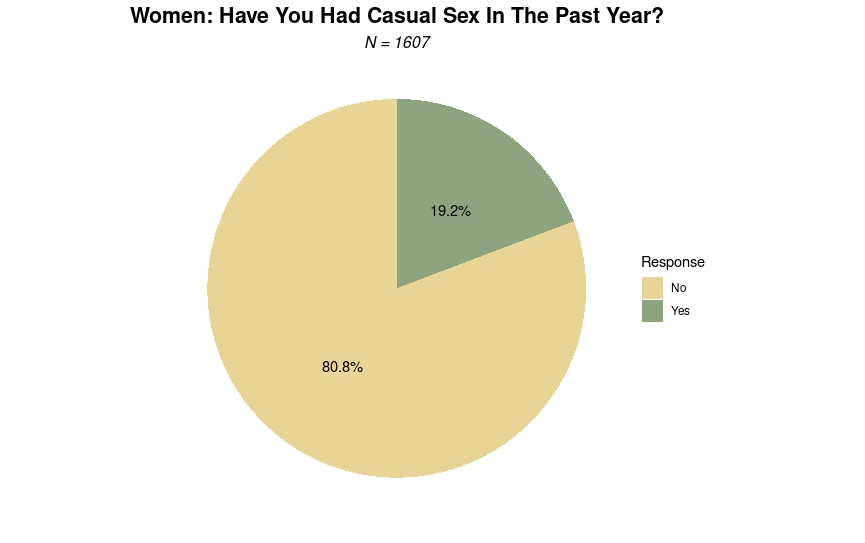
“Did you have casual sex” and “did you have sex outside of a committed relationship” are different questions. We know from the first poll that 50% of women perceive sex while dating (even with the intent of a relationship) as “casual sex,” so we should not expect the numbers to line up. However, X% of women is consistent with GSS data that shows approximately 20% of women have had more than one sexual partner in the past year:
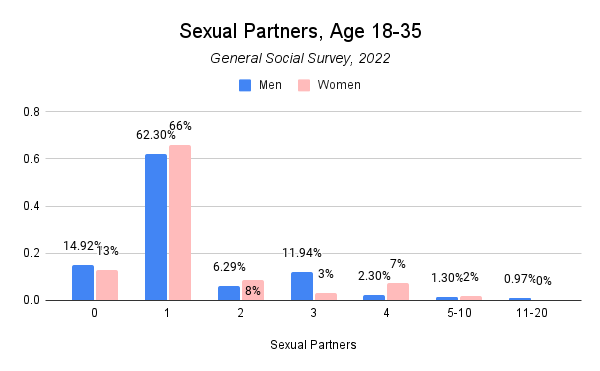
Most people are sexually active (and the GSS also shows that most sex occurs within committed relationships, see: How Many Sexual Partners Did Men and Women Have in 2022?). Additionally, a similar percentage of men and women are sexually inactive. This leaves the remaining 20% in a mating pool with one another. An additional percentage (perhaps 6-10% based on the distribution above) may accumulate an additional annual partner through serial monogamy; these are people who have switched from one committed relationship to another within the span of a year. This leaves the remaining 10% of men and women in a mating pool with one another.
These figures are consistent with what STD/STI epidemiologists have called the “promiscuous 10%” (Bellis et al., 2004; Álvarez-Dardet & Ashton, 2004). This is the simple observation that 10% of the population (men and women both) become sexually active younger and have significantly more sexual partners than the bottom 90%. As a result, these individuals also have rates of STD/STI transmission that are substantially higher. Anyone can get an STD/STI, but the disproportionate rates of transmission for this top 10% of sexually active men and women provides another line of evidence as to the prevalence of promiscuity within the general population.
Below are statistics on STD/STI transmission from recent representative datasets in the USA and the Netherlands (thanks to @nuance_enjoyer on Twitter/X for the charts). What should we expect if the top 10% of both promiscuous men and women are mostly moving within the same mating pool? Similar rates of STD/STI transmission for men and women. This is in contrast to if the the “80/20” rule (20% of men monopolizing 80% of the women) were true, in which case we would expect much higher STD/STI rates for women — and declining STD/STI rates for men if men are being pushed out of the mating pool by promiscuous “Chads” with de-facto harems. What we see is that male and female STD/STI infection rates have remained in tandem:
US Data (in order: gonorrhea, chlamydia, and syphilis):
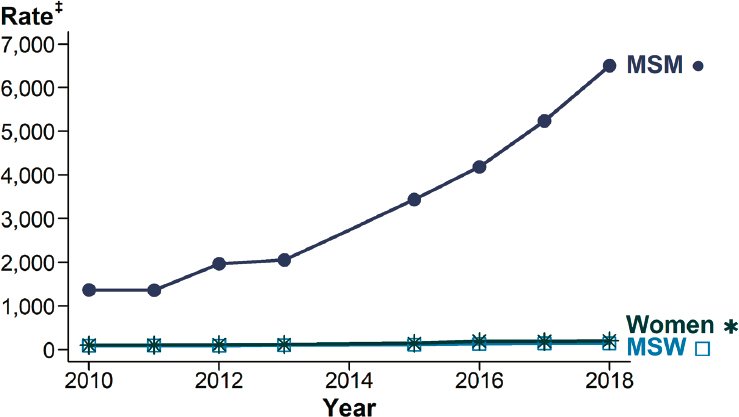
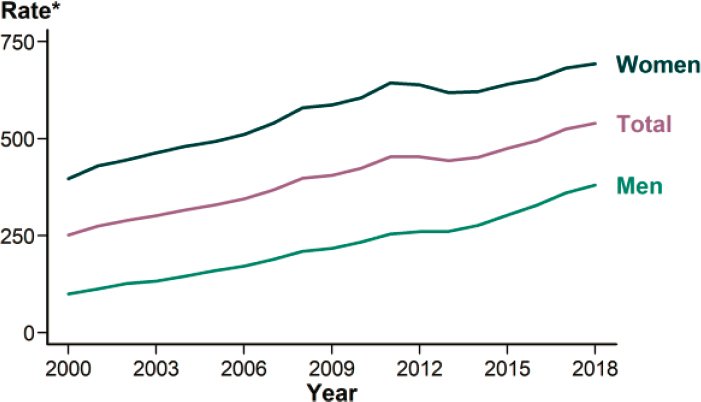
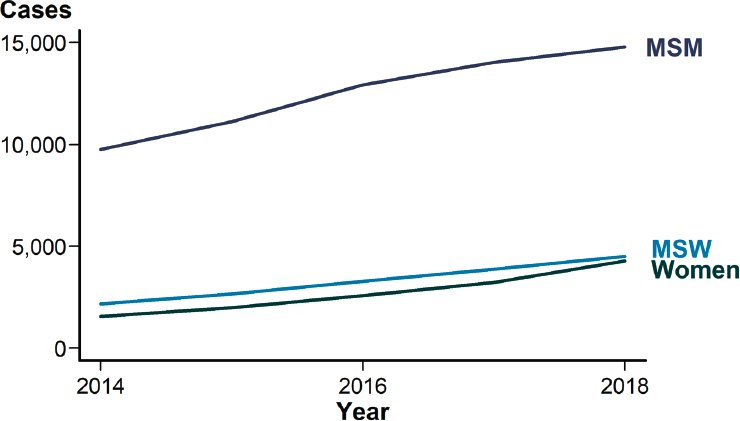
Netherlands Data (in order: gonorrhea, chlamydia, syphilis, and HIV):
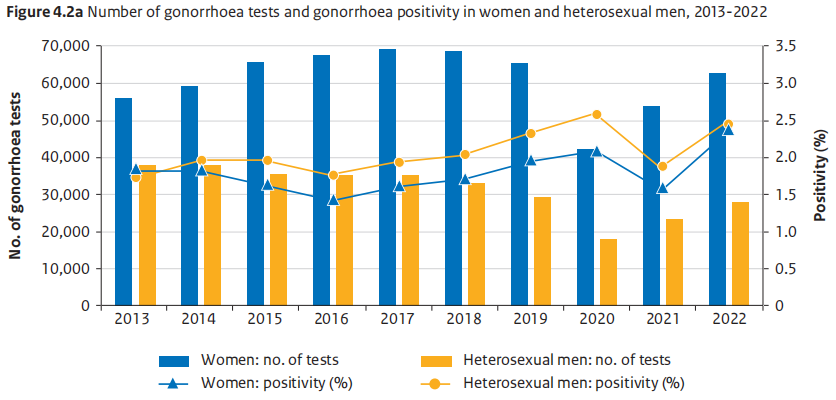
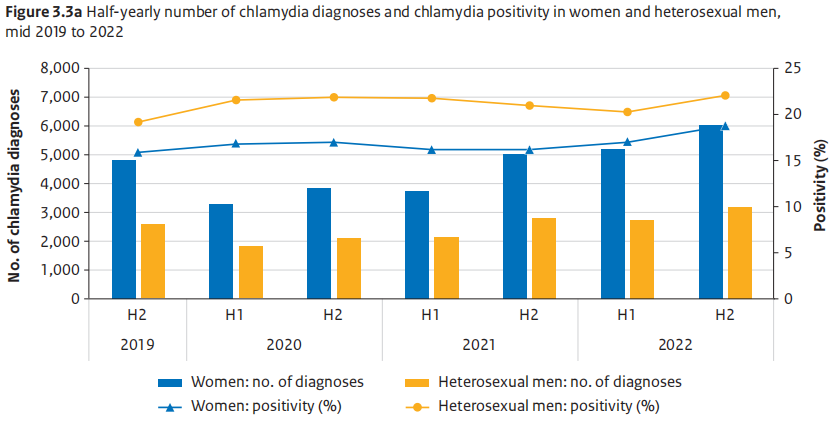
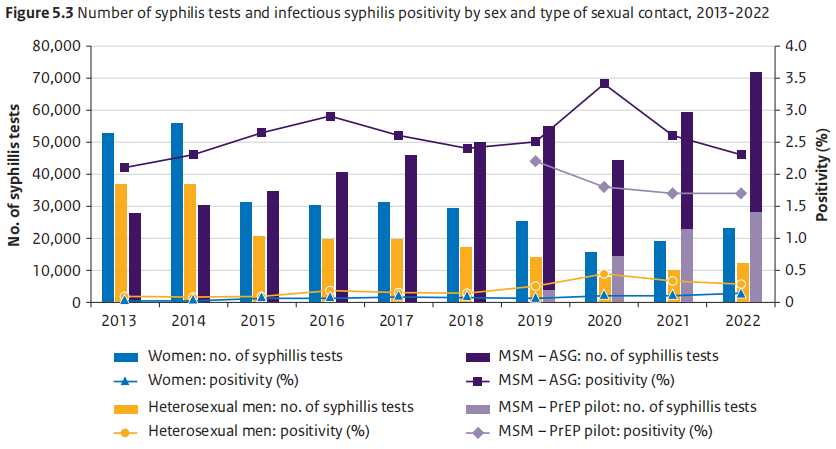
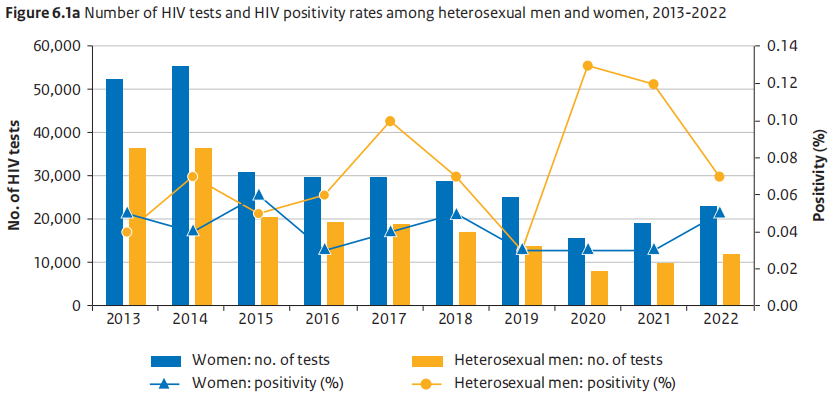
We can paint a fairly accurate picture of the sexual landscape with a correction to the infographic below. On the left is a popular meme (based on no data). The updated version on the right that I made is loosely based on the patterns described above and shown in nationally representative data (the GSS for 2021 and 2022 for example). This also shows the pattern of assortative mating for promiscuity. Rather than “Chad Harems,” or the top 20% of men monopolizing 80% of the women (and the top 20% of men are not having more sex than in past years, see: Are The Male Elite Enjoying A Sexual Boomtime?), promiscuity is concentrated within a unique pool of men and women. It is unlikely that this pool is entirely discrete (as if a promiscuous person never, ever has sex with someone who isn’t), but it is distinct, and given that most people are tied up in serially monogamous relationships (or single and sexless) at any given point of time it is unlikely that it overlaps that much.
This should not be surprising when we consider assortative mating for personality — the observation that men and women select short and long term partners with similar personality traits — and that these personality traits predict promiscuity. However, that is a long topic best suited for a future article. In the meantime enjoy the corrected meme, spread it around, and never let the manosphere forget it:
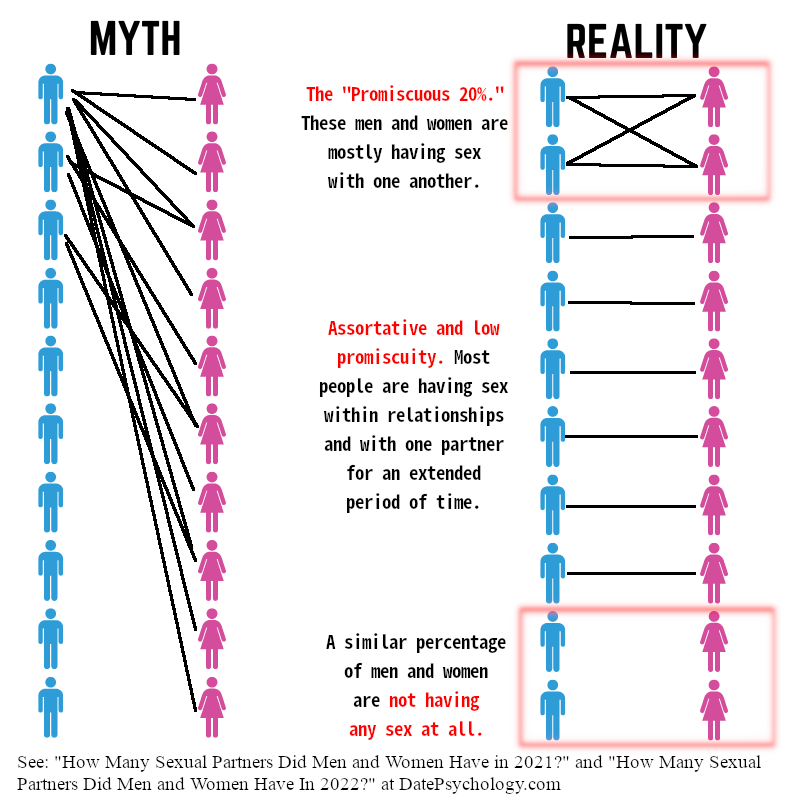
References
Álvarez-Dardet, C., & Ashton, J. R. (2004). Is there a promiscuous 10% underlying the epidemic of sexually transmitted disease?. Journal of Epidemiology & Community Health, 58(11), 885-885.
Bellis, M. A., Hughes, K., & Ashton, J. R. (2004). The promiscuous 10%?. Journal of Epidemiology & Community Health, 58(11), 889-890.
Kayaert, L., Sarink, D., Visser, M., van Wees, D. A., Willemstein, I. J. M., Op de Coul, E. L. M., … & van Benthem, B. H. B. (2023). Sexually transmitted infections in the Netherlands in 2022.
National Academies of Sciences, Engineering, and Medicine. (2021). Sexually transmitted infections: adopting a sexual health paradigm.